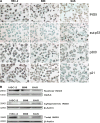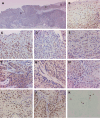Decreased nuclear expression and increased cytoplasmic expression of ING5 may be linked to tumorigenesis and progression in human head and neck squamous cell carcinoma
- PMID: 20182888
- PMCID: PMC11828150
- DOI: 10.1007/s00432-010-0815-x
Decreased nuclear expression and increased cytoplasmic expression of ING5 may be linked to tumorigenesis and progression in human head and neck squamous cell carcinoma
Abstract
Purpose: This study aimed to assess the protein level of inhibitor of growth gene 5 (ING5) in head and neck squamous cell carcinoma (HNSCC) and to explore its roles in tumorigenesis and cancer progression.
Methods: ING5 expression was assessed in 172 cases of HNSCC by immunohistochemistry using tissue microarray, and in 3 oral SCC cell lines by immunohistochemistry and Western blot. Expression of ING5 was compared with clinicopathological variables, TUNEL assay staining, and the expression of several tumorigenic markers. In addition, double immunofluorescence labeling was performed in order to analyze the colocalization of ING5 with p300 and p21.
Results: ING5 expression was primarily observed in the nuclei, but was also occasionally found in the cytoplasm of both SCC cell lines and tissue samples of HNSCC. Nuclear expression of ING5 in HNSCC was significantly lower than that of non-cancerous epithelium, and was positively correlated with a well-differentiated status. In contrast, cytoplasmic expression of ING5 was significantly increased in HNSCC, and was inversely correlated with a well-differentiated status and nuclear ING5 expression. In addition, nuclear expression of ING5 was positively correlated with p21 and p300 expression, and with the apoptotic index. In contrast, cytoplasmic expression of ING5 was negatively correlated with the expression of p300, p21, and PCNA. Although no statistical association was found between the expression of nuclear ING5 and mutant p53 in HNSCC, patients with high expression of nuclear ING5 tended to have converse prognoses when grouped according to mutant p53 expression.
Conclusions: Our results suggest that a decrease in nuclear ING5 localization and cytoplasmic translocation are involved in tumorigenesis and tumor differentiation in HNSCC. Nuclear ING5 may modulate the transactivation of target genes, and may promote apoptosis and cell cycle arrest by interacting with the p300 and p21 proteins. ING5 may function as a tumor suppressor gene or oncogene tightly linked with p53 status, and may play an important role in the prognosis of HNSCC patients. Therefore, we propose that ING5 represents a novel potential molecular therapeutic target for HNSCC.
Figures




Similar articles
-
A cisplatin-resistant head and neck cancer cell line with cytoplasmic p53(mut) exhibits ATP-binding cassette transporter upregulation and high glutathione levels.J Cancer Res Clin Oncol. 2014 Oct;140(10):1689-704. doi: 10.1007/s00432-014-1727-y. Epub 2014 Jun 10. J Cancer Res Clin Oncol. 2014. PMID: 24913304 Free PMC article.
-
Lower DSC1 expression is related to the poor differentiation and prognosis of head and neck squamous cell carcinoma (HNSCC).J Cancer Res Clin Oncol. 2016 Dec;142(12):2461-2468. doi: 10.1007/s00432-016-2233-1. Epub 2016 Sep 6. J Cancer Res Clin Oncol. 2016. PMID: 27601166 Free PMC article.
-
DYNC1I1 acts as a promising prognostic biomarker and is correlated with immune infiltration in head and neck squamous cell carcinoma.J Stomatol Oral Maxillofac Surg. 2024 Sep;125(4):101734. doi: 10.1016/j.jormas.2023.101734. Epub 2023 Dec 10. J Stomatol Oral Maxillofac Surg. 2024. PMID: 38072235
-
Systemic pharmacological treatments for chronic plaque psoriasis: a network meta-analysis.Cochrane Database Syst Rev. 2021 Apr 19;4(4):CD011535. doi: 10.1002/14651858.CD011535.pub4. Cochrane Database Syst Rev. 2021. Update in: Cochrane Database Syst Rev. 2022 May 23;5:CD011535. doi: 10.1002/14651858.CD011535.pub5. PMID: 33871055 Free PMC article. Updated.
-
Systemic pharmacological treatments for chronic plaque psoriasis: a network meta-analysis.Cochrane Database Syst Rev. 2017 Dec 22;12(12):CD011535. doi: 10.1002/14651858.CD011535.pub2. Cochrane Database Syst Rev. 2017. Update in: Cochrane Database Syst Rev. 2020 Jan 9;1:CD011535. doi: 10.1002/14651858.CD011535.pub3. PMID: 29271481 Free PMC article. Updated.
Cited by
-
Hepatitis B virus X protein-mediated non-coding RNA aberrations in the development of human hepatocellular carcinoma.Exp Mol Med. 2017 Feb 10;49(2):e293. doi: 10.1038/emm.2016.177. Exp Mol Med. 2017. PMID: 28186085 Free PMC article. Review.
-
The roles of ING5 expression in ovarian carcinogenesis and subsequent progression: a target of gene therapy.Oncotarget. 2017 Oct 19;8(61):103449-103464. doi: 10.18632/oncotarget.21968. eCollection 2017 Nov 28. Oncotarget. 2017. PMID: 29262575 Free PMC article.
-
INGs are potential drug targets for cancer.J Cancer Res Clin Oncol. 2017 Feb;143(2):189-197. doi: 10.1007/s00432-016-2219-z. Epub 2016 Aug 20. J Cancer Res Clin Oncol. 2017. PMID: 27544390 Free PMC article. Review.
-
Expression pattern and level of ING5 protein in normal and cancer tissues.Oncol Lett. 2019 Jan;17(1):63-68. doi: 10.3892/ol.2018.9581. Epub 2018 Oct 16. Oncol Lett. 2019. PMID: 30655738 Free PMC article.
-
Upregulated in Hepatitis B virus-associated hepatocellular carcinoma cells, miR-331-3p promotes proliferation of hepatocellular carcinoma cells by targeting ING5.Oncotarget. 2015 Nov 10;6(35):38093-106. doi: 10.18632/oncotarget.5642. Oncotarget. 2015. PMID: 26497554 Free PMC article.
References
-
- Barnes L, Eveson JW, Reichart P, Sidransky D (2005) World Health Organization classification of tumours: pathology and genetics of head and neck tumours, 3rd edn. IARC Press, Lyon, pp 109–110
-
- Borkosky SS, Gunduz M, Nagatsuka H, Beder LB, Gunduz E, Ali MA, Rodriguez AP, Cilek MZ, Tominaga S, Yamanaka N, Shimizu K, Nagai N (2009) Frequent deletion of ING2 locus at 4q35.1 associates with advanced tumor stage in head and neck squamous cell carcinoma. J Cancer Res Clin Oncol 135:703–713 - PMC - PubMed
-
- Cengiz B, Gunduz M, Nagatsuka H, Beder L, Gunduz E, Tamamura R, Mahmut N, Fukushima K, Ali MA, Naomoto Y, Shimizu K, Nagai N (2007) Fine deletion mapping of chromosome 2q21–37 shows three preferentially deleted regions in oral cancer. Oral Oncol 43:241–247 - PubMed
Publication types
MeSH terms
Substances
LinkOut - more resources
Full Text Sources
Medical
Research Materials
Miscellaneous

